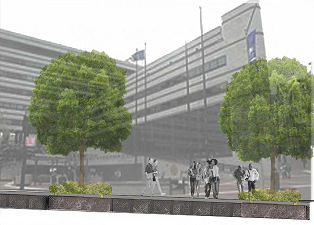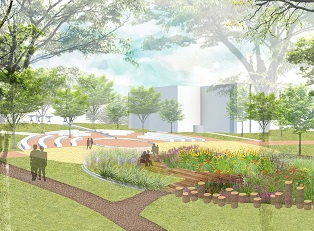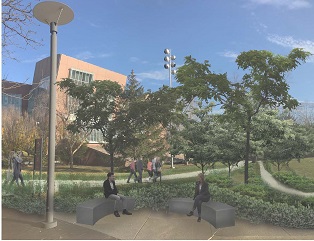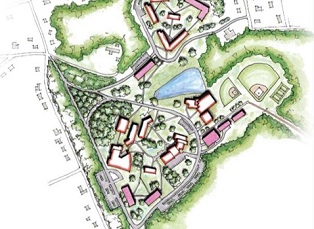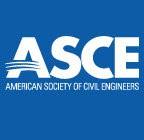2016 Campus RainWorks Challenge
On April 20, 2017, EPA announced four winners and two honorable mentions for the fifth annual Campus RainWorks Challenge. More than 60 student teams from 30 states submitted innovative green infrastructure designs. These projects show how managing stormwater at its source can benefit the community and environment by reducing the burden on local water infrastructure, managing local flooding, reducing urban heat islands, and lowering energy demands. New for this year, the competition included a focus on community engagement. Teams were asked to contemplate how public involvement with the local community, city, state, or other organizations could help support the proposed project. See the 2016 Campus RainWorks Challenge competition brief. Thank you again to our 2016 Campus RainWorks Challenge Judges.
Congratulations to the Winning Teams!
First Place Winners
- City College of New York (Master Plan category)
- Kansas State University (Demonstration Project category)
Second Place Winners
- University of Cincinnati (Master Plan category)
- University of Maryland, College Park (Demonstration Project category)
Honorable Mentions
- East Georgia State College (Master Plan category)
- University of New Mexico (Demonstration Project category)
First Place Winner (Master Plan category): City College of New York
The team’s Castor Project, is named after the school’s mascot, the Castor canadesis, more commonly known as a beaver. Taking a cue from the beaver’s role as a natural water manager, the team designed a master plan for campus-wide stormwater management. The plan calls for increasing tree canopy 15 percent by adding 89 trees and reducing impervious area 38 percent by adding 23,000 square feet of permeable surface. A water storage tank could capture up to 3000 cubic feet of stormwater for gray water uses.
Project Narrative | Design Board 1 | Design Board 2
Student Team: Agata Bugala, Alexander Fenichell, Lawrence Vulis (Environmental Engineering); Uziel Crescenzi, (Landscape Architecture); Deanna Greene (Advertising and Public Relations).
Advisors: Dr. Naresh Devineni, PhD, Krish Ramalingam (Civil Engineering Department).
First Place Winner (Demonstration Project category): Kansas State University
The team’s Stronger Quinlan project proposes repairing an historic campus nature area with green infrastructure elements to reduce stormwater pollution and flash flooding of Campus Creek. By installing rainwater harvesting and permeable pavement as well as planting trees and native plants, the students estimate their design could reduce stormwater runoff by 46 percent and capture 597,000 gallons of water per year for irrigation.
Project Narrative | Design Board 1 | Design Board 2
Student Team: Kelsey McDonough, Erica Schmitz (Biological and Agricultural Engineering); Joseph Weeks (Agronomy); Joe Krauska (Entomology); Conner Bruns, Tsz Wai Wong (Landscape Architecture).
Advisors: Trisha Moore, Ph.D. (Biological and Agricultural Engineering); Lee Skabelund, Jessica Canfield (Landscape Architecture & Regional Community Planning); Mark Taussig (Campus Planning and Project Management).
Second Place Winner (Master Plan category): University of Cincinnati
Titled ReMEDiation, the team’s master plan envisions installation of green infrastructure best management practices that mitigate stormwater runoff on campus and reduce flooding and combined sewer overflows into the Ohio River. The team estimates that enhanced green spaces can reduce stormwater runoff by 25 percent and increase community benefits of urban gardens and nature trails.
Project Narrative | Design Board 1 | Design Board 2
Student Team: Zoe Kusnier (Horticulture); Binita Mahato (Urban & Regional Futures); Karyn Loughrin, Samantha McLean, Alyssa Wissel McClearnon (Community Planning).
Advisors: Leah Hollstein, PhD (School of Planning).
Second Place Winner (Demonstration Project category): University of Maryland, College Park
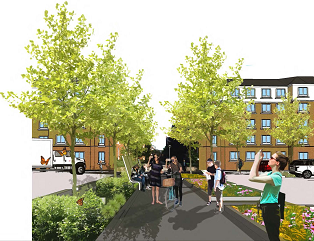 The team project, (Un)loading Nutrients, proposes transforming a campus loading dock into a campus amenity that also manages stormwater. The plan calls for 6660 square feet of new plantings for bioretention and reducing impervious surface by 18 percent. The students redesign of the loading dock and adjacent parking lot creates a safer pedestrian walkway between a dining hall and classroom building.
The team project, (Un)loading Nutrients, proposes transforming a campus loading dock into a campus amenity that also manages stormwater. The plan calls for 6660 square feet of new plantings for bioretention and reducing impervious surface by 18 percent. The students redesign of the loading dock and adjacent parking lot creates a safer pedestrian walkway between a dining hall and classroom building.
Project Narrative | Design Board 1 | Design Board 2
Student Team: Mark Dennis, Dylan Reilly, Vince Yi (Landscape Architecture); Michael Van Wie (Mechanical Engineering); Emma Giese, Tuana Phillips (Environmental Science and Technology); Christiane Machado (Architecture).
Advisors: Victoria Chanse, PhD, Dennis Nola, Jack Sullivan (Plant Science and Landscape Architecture); Michael Carmichael, Christopher Ho, William Olen, Oswell Osei, Stephen Reid, Paul Romero (Facilities Management); Allen Davis, PhD (Civil & Environmental Engineering); Peter May, PhD, Mitch Pavao-Zuckerman, PhD (Environmental Science and Technology).
Honorable Mention (Master Plan category): East Georgia State College
Campus in the Pines reimagines a more resilient institution while creating the first stormwater management and green infrastructure plan for their campus. The team developed a master plan that reinforces an academic environment, creating a walkable landscape that highlights practical green infrastructure practices that can mitigate stormwater pollution from existing and proposed development. The framework provided will transform the campus into a sustainable institution, acting as a model of resiliency and smart growth in the region.
Project Narrative | Design Board 1 | Design Board 2
Student Team: Norman Bevan (Biology – East Georgia State College); Ming Guan, Carter Ricks, Danielle Schwartz, Yuwen Yang, Danielle Valdes (Landscape Architecture - University of Georgia).
Advisors: David Chevalier (East Georgia State College - Department of Biology); Robert Vick, PLA, LEED Fellow (University of Georgia - College of Environment & Design).
Honorable Mention (Demonstration Project category): University of New Mexico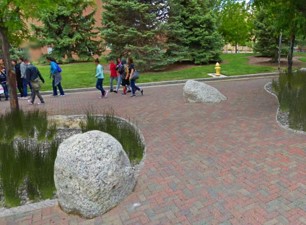
FLOW: A Proposal for Stormwater Design on the University of New Mexico Campus focuses on areas of campus with recurring flooding problems and areas that showed promise for effective reduction of stormwater runoff, runoff disconnection, rain water harvesting, and rain gardens while adhering to constraints imposed by the local climate and water authorities. This project reflects a unique example for campuses in arid regions.
Project Narrative | Design Board 1 | Design Board 2
Student Team: Nirit Finkelstein (Water Resources); Jeremiah Gwin (Landscape Architecture); Rachael Miera, Fatima Quarashi, Jared Romero (Civil Engineering); Maggie Seibert (Health Communication); Matthew Segura (Community and Regional Planning & Water Resources); Christopher Simmons (Civil Engineering).
Advisors: Mark Stone, Ph.D., P.E., D.WRE: (Civil Engineering).
Cooperating Organizations
These cooperating organizations assisted EPA with judging and outreach:
American Society of Landscape Architects Exit
American Society of Civil Engineers Exit
Water Environment Federation Exit
To sign up for e-mail updates or ask a question about the Campus RainWorks Challenge, e-mail RainWorks@epa.gov.


